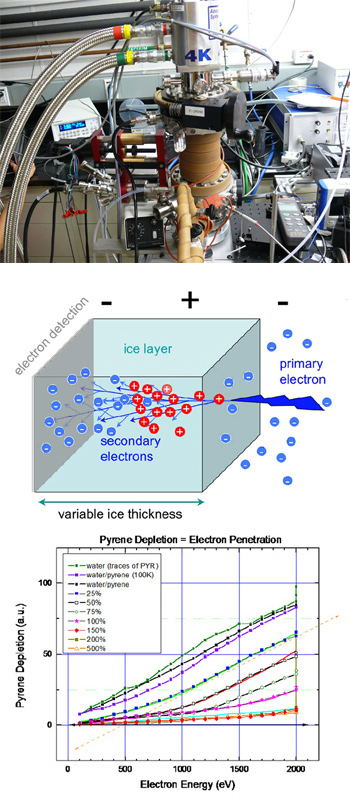
Middle: An illustration of how electrons degrade PAH through ice.
Bottom: Laboratory data (observed) and modeled (solid) depletion of PAH at various ice depths due to reactions with electrons.
Future instruments onboard NASA spacecraft will need to be able to accurately measure radiation processing of icy surfaces. Radiation constantly bombards outer planets in our solar system, but how that bombardment affects our ability to see through icy surfaces is a question of great importance to mission designers. In order to better understand surface properties of icy bodies such as Europa, Enceladus, and Ganymede, scientists at JPL demonstrated the use of polycyclic aromatic hydrocarbons (PAHs) as probes to study quantitative electron penetration into ice. This research could enable us to improve on our ability to detect organics on icy bodies under high radiation environment utilizing remote-sensing and in-situ measurements.
The most important question to answer first though, is “can astrobiologically important organics survive and evolve in near-surface ices under extreme radiation environments?”. Studies on this very question were conducted at JPL’s “Ice Spectroscopy Lab (ISL)” lead by Dr. Gudipati, where ices were kept at 30 K (on a 4 K cryogenic system). The experiment system was comprised of an electron gun mounted on a translation stage (left on the gun system), a sample entry toward the viewer, and on the right, fiber optics for UV transmission (absorption) spectroscopy.
Irradiating the Ice
In this experiment, polycyclic aromatic hydrocarbons were embedded in a thin ice layer, whose thickness was precisely determined to the nearest 10 nm. PAHs were placed in ice analogs at various thickness levels. Ultraviolet-visible spectroscopy (UV-VIS) was then used to monitor the remaining PAH concentration at different thickness levels to see how far the electrons had penetrated the surface.
From this study, scientists were able to learn several things about how well electrons can be used to penetrate planetary ices: # Low-energy electrons penetrate deeper than predicted by existing models. Even low-energy (100 eV – 2 keV) electrons could first ionize and then destroy organics within several hundred nanometers to a few microns of the ice surface, the penetration being proportional to the electron energy. # Chemical processes observed here are comparable with the chemistry that could occur due to the secondary electrons and photons generated in the ice by the high energy electrons (keV - MeV) bombarding Europa. # Trapped excess surface electrons could repel incoming magnetosphere electrons and need to be further studied.
These findings are somewhat surprising at the first sight: why do we see deeper penetration of electrons than predicted? It becomes easy to understand when all dots are put together.
Organic molecules typically need less than 10 eV to be destroyed through ionization and dissociation. Earlier work of Dr. Gudipati has shown that in ice environment, organics can be ionized with less energy than they would in their gas-phase. Consequently, energy needed to reach an organic molecule to initiate its destruction is even smaller by 2-3 eV. When electrons bombard icy surfaces, as they penetrate through the ice, they produce secondary electrons and photons, which can destroy organics. Photons travel deeper than electrons. Consequently, significant destruction of organics can occur at far deeper depths than the theoretically extrapolated electron penetration depths in ices.
In a nutshell, these findings suggest that destructive energy of electrons can reach deeper into the ice and that life or organics on icy surfaces under radiation (such as is the case on Europa) may only in the subsurface.
Future Mission Implications
So far there have not been direct quantitative electron penetration measurements (energy vs. depth) on ices. All current models use data derived from other targets such as silicon. Experiments in this study have shown that electrons penetrate deeper than predicted by existing models. Scientists plan to extend these experiments to higher electron energy region for further model comparison. Organics in ices are easily destroyed even with low-energy electrons, implying that it may be difficult to detect organics on highly irradiated surfaces and subsurface probing may be inevitable.
The proposed Europa Jupiter System Mission (EJSM), with its focus on Europa and Ganymede, will benefit from a proper understanding of radiation processing of icy surfaces. This research not only helps in this regard, but could also improve on data analysis of present and future flagship missions to icy bodies.
Research discussed here was funded by JPL's Director’s Research and Development Fund (DRDF).